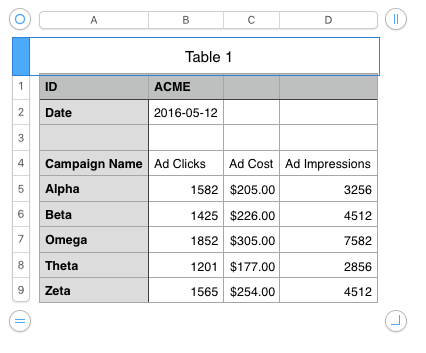What is a CSV file?
Do you use data sources that we haven’t yet integrated into DashThis, or any other types of custom data, and you would like to add them to your dashboards? CSV files are the way to go!
A CSV file is basically a spreadsheet that was exported in a Comma Separated Values format. It means the file consists only of rows and columns: plain data without any formatting. This format is typical of almost all tools that allow data exportation. You can either export such a file from a tool or platform you’re using or create it from scratch in a spreadsheet editor and then export it in a CSV format.
Here’s an example of how a CSV file looks like:
ID,ACME,,
,,,
Date,2016-05-12,,
Campaign Name,Ad Clicks,Ad Cost,Ad Impressions
Alpha,1582,$205.00,3256
Beta,1425,$226.00,4512
Omega,1852,$305.00,7582
Theta,1201,$177.00,2856
Zeta,1565,$254.00,4512
And here is how a CSV looks like in a spreadsheet tool:
If you export a CSV file from a tool or a platform, you can easily modify it. Open it in a spreadsheet editor, change what you need, and export it once again in a CSV file format. There you go!
Please note that your file needs to fit into a certain structure to be read by our system. Here are the most important elements:
- – An ID and a date are mandatory;
- – Metrics are read in columns;
- – Dimensions are read in rows.
You want to use a CSV file as a data source in your dashboards? Follow these 6 steps!
If you want, you can use our template to build your file: test_dashthis.csv
You can’t export your data from DashThis to a CSV file — the only available export option is PDF.

